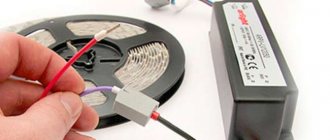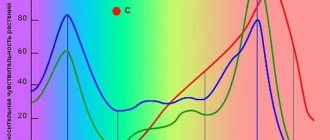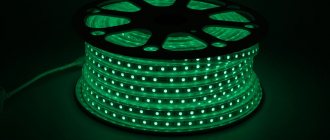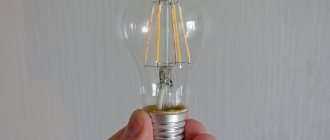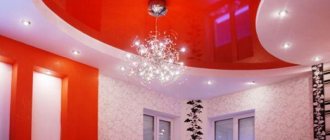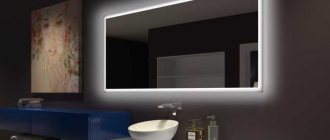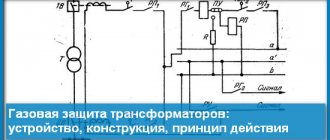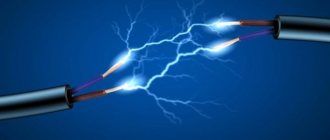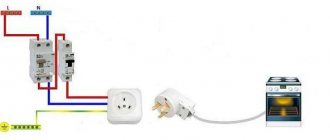The use of LED strips for lighting residential, office and commercial premises today will not surprise anyone, but the popularity of LED technologies is due not only to fashion. Semiconductor light sources have low power consumption and a long service life. Their only drawback is their higher cost compared to other types of lighting devices. At the same time, the price factor is significantly influenced by the price of the electronic ballast (transformer), the power supply necessary for the operation of the LED strip.
In this publication we will consider a number of issues related to power supplies for LED light sources. The collected information will help you select an adapter based on power and voltage, correctly connect the tape to it, and also make a simple power supply for lighting with your own hands.
What is electronic ballast and why is it needed?
The need for this device is due to the fact that the supply voltage of strip LEDs is 12 volts (or 24 volts). Accordingly, to connect to the home electrical network you will need a 12-volt step-down power supply, equipped with an AC-to-DC voltage converter.
Despite the fact that both switching and transformer power supplies can be used to operate devices, the latter are not widely used. This is due to both the large dimensions and weight, which pose the problem of where to hide such an adapter, and the low efficiency. In addition, the power transformer “buzzes,” which causes a fair amount of discomfort. But due to the ease of implementation, such schemes are popular among beginning radio amateurs.
Manufacturers of power supplies for diodes prefer to use pulsed circuits, which allows them to increase the power of the adapters and reduce their size and cost. Detailed information about switching power supplies can be found on our website.
Sometimes such power supplies are called “transformers” for LED strips, which is not entirely correct, because we are talking specifically about pulse voltage converters, but since this term is firmly established, we will also use it.
Types of drivers
There are several types of power supplies for LED lamps on sale. The main ones are the following:
- capacitor circuit;
- resistor;
- driver with low-voltage input;
- chip HV9910;
- network driver;
- LM317 chip.
The choice depends on the characteristics of the device and its operating parameters.
Power supply options for LED strips
Depending on the functional purpose, electronic ballast is available in the following versions:
- In the form of a compact network power supply. Such devices look like regular chargers for mobile devices.
Compact network power supplies for LED strips
This solution can be called an economical option, since of all types of execution it is the lowest in cost. The downside is low power, as a rule, it does not exceed 30-36 W (there are Chinese products with 60 W, but in them this parameter is greatly overestimated). The main area of application is connecting simple lighting. The main advantage is that no installation is required; the driver just needs to be plugged into a socket, having previously connected a tape to the output.
- Compact unit housed in a sealed plastic case. The maximum power of such devices is 75 W. The 100 W figure found on Chinese products is not true.
Sealed compact electronic ballast, sealed from external influences
Distinctive features: light weight, compact size, protection from moisture and dust. This is an almost ideal option for organizing lighting in ceiling niches, if you do not take into account the high cost of the adapter (almost twice as expensive as analogues with a non-sealed housing).
- Electronic ballast in a sealed aluminum housing. This version is designed for harsh operating conditions. The scope of application of such power supplies is lighting of outdoor advertising, lighting of buildings and other objects where high-power LEDs are installed. Installing household light sources as an adapter is not economically justified.
Arlight power supplies in a sealed aluminum case
Distinctive features: resistance to mechanical stress and destructive natural factors (rain, snow, UV radiation). As for power, taking into account the frequent production of such adapters on special orders, it can be in a fairly wide range. For standard products, this parameter is usually from 80 to 200 W. The price is significantly higher than other options.
- Leaky ballast. The most popular power supply unit is widely used to power lighting in apartments, offices and retail spaces. It costs a little more than a compact network unit, but can be much more powerful with the same dimensions.
PSU in non-hermetic version
Powerful devices of this type can be equipped with forced ventilation, which ensures cooling of electronic components, which extends the life of the adapters. They are manufactured for 12 or 24 V voltage. The low price and wide range, allowing you to choose the most optimal option, have made such power supplies the most popular. https://www.youtube.com/watch?v=xsyVQBIUFR0
Product characteristics
LED strips are long elastic boards on which contacts and diodes are located. There is a certain distance between them. To limit the current flowing through the system, special resistors are soldered into the structure.
Designers often use LEDs for interior decoration, visually expanding the space of a room, and hiding light sources when arranging various ceiling structures.
There are several types of LED designs. Some of them :
- Adhesive. To fix the product, it is necessary to remove the protective film from the adhesive layer and, bending the tape at the desired angle, apply it to a flat surface.
- Glueless. Special plastic brackets are used for fastening.
- Moisture-proof ones are in demand when installing lighting in rooms where there are high humidity levels.
- Sealed ones are needed for lighting systems in places of high humidity, as well as in swimming pools.
- Open. Used for mounting lighting under ceiling structures or on walls.
- Multicolor systems change color characteristics under the influence of a special element - a controller.
- Single color (white). Their brightness level can be adjusted with a special dimmer.
Ice systems can have a varied number of lighting elements of various types. The most popular devices are marked 3528 or 5050. Digital values indicate the size of the diodes: 3.5 by 2.8 mm or 5 by 5 mm. The first ones are equipped with a special plastic case with one crystal. The latter also feature a plastic design that houses three crystals, so they illuminate much brighter.
In addition, today double-row systems with many diodes are produced. In stores you can purchase new products that are equipped with SMD 2850 chips. With their help, the light characteristics are significantly improved.
Due to their low cost and high light output, the products are becoming popular every day. Such tapes operate in a safe mode with reduced current levels. This factor helps to increase the service life without loss of brightness. They can work 50 thousand hours. These are the figures stated by the manufacturer.
You may be interested in this Features of an incandescent light bulb
Advantages of designs
LED systems are characterized by minimal electricity consumption. Now there are many types with different power ratings from 4.8 to 14.4 W/min and higher. Diodes produce fairly bright light, so they can be used not only for auxiliary lighting, but also as the main light source. Often, the brightest LED-TED strips are used for this.
LED lighting has a number of undeniable advantages compared to other lighting systems. Some of them :
- Long service life of at least 10 years.
- Lighting is distributed evenly over the entire room.
- High fire safety indicators.
- The light remains bright throughout the entire operational period.
- Environmentally friendly materials in the composition.
- Minimum electricity consumption.
- Possibility of fixing the tape at different angles.
- Varied color palette.
- LEDs do not contain mercury.
- Resistance to radio interference.
- A minimum of thermal energy is released into the room.
Briefly about management
Speaking about drivers for LED strips, one cannot fail to mention the devices that control their lighting, in particular, dimmers and RGB controllers.
Since switching power supplies are used for power supply, it is not possible to regulate the intensity of the strip LEDs by changing the voltage, as for incandescent lamps. For this purpose, you will need to purchase a special device - a dimmer, for example the one shown in the figure below.
Dimmable module for monochrome LED strip
Such a device is connected to the gap between the power supply and the tape.
To control RGB strips, a special device is used, as a rule, it is based on a microcontroller. As a rule, it is “protected” by several programs that allow you to both control the intensity of the glow with a predominance of one color or another, and use other lighting effects (videos demonstrating them are easy to find on the Internet).
RGB controller with remote control
The controller is turned on in the same way as the dimmer (between the power supply and the tape).
Operating principle of LED lamps
An LED light bulb is a semiconductor element containing several layers responsible for converting the current flowing through them into visible light.
Important! When the composition of this layer changes, radiation of a certain color (red, green, yellow or blue) is generated in it.
Since LED bulbs need to produce pure daylight, their designers had to use a little trick of coating the blue emitter with a yellow phosphor. In this design, under the influence of photons in the blue range, the yellow phosphor begins to emit its own colorless radiation.
How to choose a transformer for LED strip?
First of all, it is necessary to determine the main characteristics of the power supply. For us the following are significant:
- input voltage.
- output voltage.
- rated load current.
There will be no difficulties with the first parameter; it must meet the standards of the home electrical network. The output voltage must be selected according to the power supply of the tape; it should be 12 or 24 volts. As for the power of the adapter, it is calculated based on the rated load current, taking into account the characteristics of the tape and its expected length. We'll tell you in detail how it's done.
Calculation of power supply power for LEDs
To calculate how much power a power supply needs, first let’s remember the derivative of Ohm’s law: in our case, P is the calculated power, I is the rated load current, U is the supply voltage.
The question is what does the length of the tape have to do with it? It’s easier to explain with an example. Let's say that to implement the project we need three meters of monochrome SMD 3528 12 volt tape. The table of its characteristics indicates a power of 4.8 W/m. Based on this, the calculated power for 3 meters will be 14.4 W. Taking into account the optimism of manufacturers, we add a margin of 30%, and we get 18.42 W. Therefore, we will need a power supply with a load current of at least 1.5 A (18.42/12).
As you can see, there is nothing complicated in the calculations; the main thing is to take into account the load characteristics. As an example, below is a table showing what types of 12 volt LEDs there are.
Table: example of characteristics of 12 volt LED strips
Please note that the standard length of the tape is 5 meters, but it is allowed to use smaller pieces (how the cut is made is indicated on our website) or connect two full-size pieces or more at once. How to do this will be discussed below.
Classification and principle of operation
The power supply comes in two versions:
- transformer based;
- pulse device.
Both options supply 12 volts to the input of the lighting fixture. The transformer power supply is characterized by rather large dimensions, which sometimes complicates the installation task. There are other disadvantages to such models: susceptibility to network overloads, as well as low efficiency. The pulse analogue, on the contrary, is compact, making it easy to hide anywhere.
The operating principle of such devices is to reduce the mains voltage to the required level (12V, 24V). Moreover, unlike drivers (providing stable current) used to power LEDs in LED lamps, the power supply is a voltage source.
Accordingly, the lighting device is not limited in current by this device. For this purpose, the design of the diode strip provides current-limiting resistors.
Different types of transformers
There are different types of transformers, different in design:
- compact plastic case;
- aluminum sealed housing;
- perforated body.
Each option is designed for use in different conditions. For example, the second option can come into contact with water without changing the characteristics, and a power supply with a perforated case, on the contrary, is used only in dry rooms and must be well protected from dust.
Connecting a transformer to an LED strip
As a rule, this stage does not cause difficulties, since most manufacturers, such as Feron or Arlight, include detailed instructions with their products. For those who have chosen a nonname, we will tell you how to connect an LED to 24 or 12 volts.
Two connection schemes are practiced: direct and parallel, they are presented below in the picture.
Connection diagrams A) straight; B) parallel
As a rule, a sequential connection scheme for several tapes is not practiced, except in cases where the total length of the tape does not exceed 5 meters.
The wires are attached to the DIN rail on the power supply unit, where the purpose of each contact is indicated (an example is shown in the photo below).
An example of connecting a tape to a power supply
The wires are soldered to the tape or special adapters are used for connection. As for the distance from the power supply to the tape, the smaller it is, the better. In practice, adapters are rarely installed far from light sources, so the cable length is not taken into account.
Types of LEDs
Due to different approaches to assembling semiconductor chips, it was possible to create the following types of LED emitters:
- DIP - LED lamps made on the basis of a crystal with a lens placed on top and two lead conductors. This option is the most common in practice and is used to organize lighting in various lighting devices;
- The so-called “Piranha”, partially reminiscent of the previous design, but having four terminals. Increasing the number of contacts increases its reliability and improves heat dissipation (see figure below);
Piranha lamp
LED lamp repair
Additional Information. Such LEDs are mostly used in the automotive industry.
- SMD LED emitters can be placed on flat surfaces, due to which it is possible to reduce the dimensions of the lamp and also improve heat dissipation properties. They are available in a wide variety of designs and are used in modern light sources;
- Products manufactured using COB technologies, according to which the chip is soldered directly into the board. Due to this device, the semiconductor ice junction is reliably protected from oxidation and overheating. At the same time, the intensity of the diode glow increases significantly.
Note! The peculiarity of the above versions is that if the LED burns out, it will have to be replaced completely, since it is impossible to repair these products by replacing a separate chip.
Another disadvantage of such LEDs is their small size, which forces them to be assembled in groups of several pieces. In addition, the crystal built into them gradually ages, as a result of which the brightness of the ice emitter decreases over time. Next, we will consider the design of a 220V LED lamp.
Homemade 12 volt transformer power supply
In conclusion, we present a simple power supply circuit for powering an LED light source with a power of up to 120 W based on the KR142EN8B integrated stabilizer.
Power supply circuit for 12 volt LED strip
Designations:
- Resistors: not used in the circuit.
- Capacitors: C1 and C2 – 100 nF; C3 – 1000 µF x 25 V; C4 and C5 -2200 uF x 25 V.
- Rectifier: VD1 – diode bridge KVRS 15005 or any other, designed for a current of at least 10 amperes;
- Diode VD2 – 1N4005 (any silicon diode will do as an alternative).
- Transistor VT1 is TIP 3005; in fact, any bipolar circuit with a collector current of 10.0 A or more is suitable.
- The DA1 chip is an integrated stabilizer KR142EN8B; as an alternative, you can use MC7812VT or similar analogues.
- TP1 – it is allowed to use any step-down transformer with a secondary winding designed for a voltage of 12-18 V and a load current of 10.0 A.
The assembled circuit does not require adjustment if the assembly was done correctly. This power supply can power both a regular 12 volt 60 watt strip and more powerful light sources.
Assembling a switching inverter power supply from scratch is futile. It is easier to adapt a ready-made device for this purpose, for example, take an electronic balance from energy-saving lamps that burned out in a chandelier and repair it by making small changes (increase the voltage and current consumption). In essence, these are ready-made switching power supplies.
Brief review and testing of popular LED lamps
Although the principles of constructing driver circuits for various lighting devices are similar, there are differences between them both in the sequence of connecting the elements and in their choice.
Let's look at the circuits of 4 lamps that are sold in the public domain. If desired, you can repair them yourself.
Image gallery
Photo from
Driver for disassembled lamp BBK P653F
Compact lamp Ecola 7w
Collapsible analogue of Ecola GU5.3
Jazzway 7.5w GU10 – suitable for repair
If you have experience working with controllers, you can replace the elements of the circuit, resolder it, and slightly improve it.
However, meticulous work and efforts to find elements are not always justified - it is easier to buy a new lighting fixture.
Option #1 – LED lamp BBK P653F
The BBK brand has two very similar modifications: the P653F lamp differs from the P654F model only in the design of the emitting unit. Accordingly, both the driver circuit and the design of the device as a whole in the second model are built according to the design principles of the first.
The board has compact dimensions and a well-thought-out arrangement of elements, for the fastening of which both planes are used. The presence of ripples is explained by the absence of a filter capacitor, which should be at the output
It's easy to spot flaws in the design. For example, the installation location of the controller: partly in the radiator, if there is no insulation, partly in the base. The assembly on the SM7525 chip produces an output of 49.3 V.
Option #2 – Ecola 7w LED lamp
The radiator is made of aluminum, the base is made of heat-resistant gray polymer. On a half-millimeter thick printed circuit board there are 14 diodes connected in series.
Between the heatsink and the board there is a layer of heat-conducting paste. The base is fixed with self-tapping screws.
The controller circuit is simple, implemented on a compact board. The LEDs heat the base board to +55 ºС. There is practically no pulsation, radio interference is also excluded
The board is completely placed inside the base and connected with shortened wires. The occurrence of short circuits is impossible, since there is plastic around - insulating material. The result at the controller output is 81 V.
Option #3 – collapsible lamp Ecola 6w GU5.3
Thanks to the collapsible design, you can independently carry out repairs or improve the device driver.
However, the unsightly appearance and design of the device spoils the impression. An oversized radiator increases the weight, so additional fixation is recommended when attaching the lamp to the socket.
The board has compact dimensions and a well-thought-out arrangement of elements, for the fastening of which both planes are used. The presence of ripples is explained by the absence of a filter capacitor, which should be at the output
The disadvantage of the circuit is the presence of noticeable pulsations of the light flux and a high degree of radio interference, which will certainly affect the service life. The controller is based on a BP3122 microcircuit, the output value is 9.6 V.
We discussed more information about Ecola brand LED light bulbs in our other article.
Option #4 – Jazzway 7.5w GU10 lamp
The external elements of the lamp are easily detached, so you can get to the controller quickly enough by unscrewing two pairs of screws. The protective glass is held in place by latches. The board contains 17 diodes with serial communication.
However, the controller itself, located in the base, is generously filled with compound, and the wires are pressed into the terminals. To free them, you need to use a drill or use desoldering.
The disadvantage of the circuit is that the function of a current limiter is performed by a conventional capacitor. When the lamp is turned on, current surges occur, resulting in either burnout of the LEDs or failure of the LED bridge
There is no radio interference - all thanks to the absence of a pulse controller, but at a frequency of 100 Hz there are noticeable light pulsations, reaching up to 80% of the maximum value.
The result of the controller is 100 V output, but according to the general assessment, the lamp is more likely to be a weak device. Its cost is clearly overestimated and is equal to the cost of brands that are distinguished by stable product quality.
We presented other features and characteristics of lamps from this manufacturer in the next article.
Related questions
Quite often you can hear the question of where 24 volt strips are used; as a rule, they are used for lighting. They can be attached with adhesive tape to a special substrate that dissipates heat or placed in a profile for an LED strip mounted on the ceiling or walls. The selection of a power supply, power calculation and connection diagram for LEDs to 24 volts is carried out according to the same principle as described above.
What to do if one or more diodes burn out? Repair in this case does not require much effort. It is necessary to visually find the burnt segment; it is quite easy to identify it by its appearance; then it is cut out according to the marks on the tape. The remaining pieces should be connected with a wire of the appropriate cross-section, observing polarity. SMD elements are quite small, there is no point in re-soldering them; it is better to remove the burnt-out segment. The loss of one of them will not globally affect the total power of the light source.
How many tapes can you connect to the power supply? It all depends on the power of the adapter and the characteristics of the light source that is powered by it.
What should I do if I hear crackling or other unusual sounds from the electronic ballast? You should immediately turn off the power and perform a technical inspection of the device.
Key selection parameters
To select a power supply for an LED strip, you need to pay attention to several basic technical characteristics of such devices:
- the voltage level at the output of the block must correspond in value to the light source that will be connected;
- the power value of the device; to determine the design suitable for the load, a simple calculation should be performed;
- degree of protection;
- the need for additional functions in the block.
When deciding which power supply to choose, it is recommended to take into account its cost. Moisture-proof versions will cost more. Pricing is also affected by the level of power and voltage. The simplest option can be bought for 200 rubles. (protection level IP20), expensive versions can be found at a maximum price of up to 5,000 rubles. (waterproof housing, 250W).
The transformer heats up during operation
If you bought a new transformer, which after connecting and turning on began to get very hot, you need to carry out several operations:
- Check the power consumption load in the room and the compliance of the permissible rating of the transformer with the number of lamps connected to it.
- Check the wiring of sockets and lighting in groups.
- Check if there is a load on the device.
- Look at reviews on the Internet for the purchased device. It is quite possible that a low-quality transformer was purchased.
If a transformer that has been in use for several years heats up, this is an indicator of wear and tear on the equipment. It should be replaced with a new one. It is better not to ignore these signals, as you may encounter melting of the housing, and this will create a risk of a fire hazard.
Installation Features
The transformer is a remote device, but this type of installation does not suit everyone, as you don’t want to spoil the interior with additional equipment. Hiding such a device and at the same time ensuring normal interaction with it will not be difficult if the house has suspended ceilings or false walls.
Ideally, the devices are fixed to a concrete slab. To provide easy access to them, a small hatch is made in the surface of the wall or ceiling. It should be taken into account that over time the device will need to be changed, so the mortise hole must correspond to its dimensions.
The decision to hide a transformer in a closet is not always advisable, especially if several devices will be installed. There should be no more than 2 meters of wire to the load source, so placing the transformer far from the lamp will not work. To avoid all these problems, it is recommended to buy lamps with a built-in transformer.
